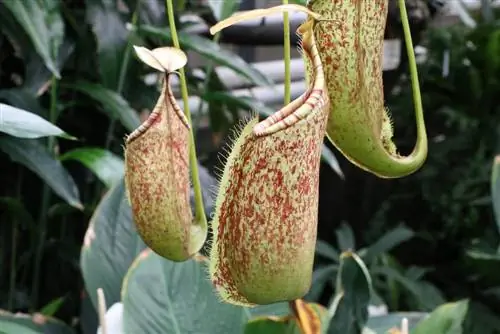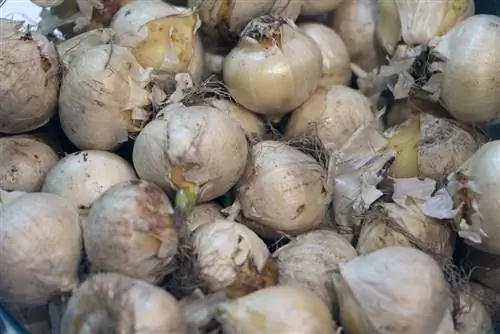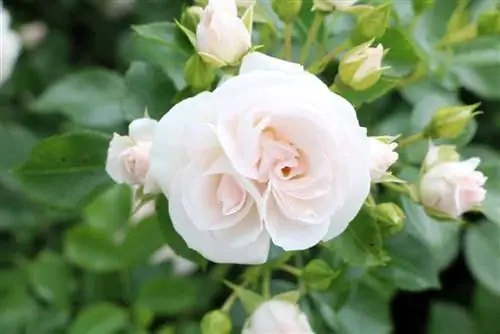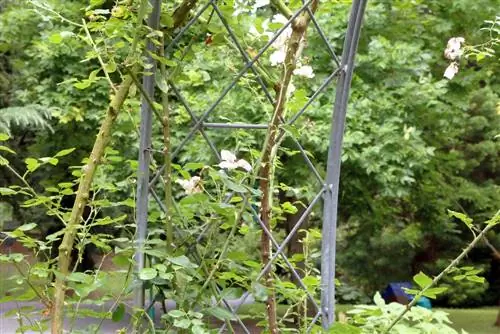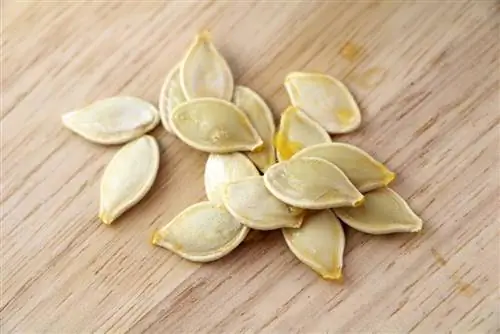- Author admin [email protected].
- Public 2023-12-17 03:39.
- Last modified 2025-01-24 12:45.
Apparently plants also like it when they are something special. Some plants therefore adorn themselves with fragrant flowers, while other plants have attractive foliage. Both are probably too boring for the pitcher plant; it prefers to decorate itself with “jugs” and use them to catch insects. If you would like to expand your pot collection with a few attractive specimens, you can try to propagate your Nepenthes.
Is propagation possible?
If the existing pitcher plant is thriving, the desire to add more pitcher plants quickly arises. You don't have to buy new plants to expand your collection. If it can be the same variety, propagation is a viable alternative. It's fun and cheaper than buying new. However, it also requires a little gardening experience, skill and knowledge about caring for the demanding carnivores. Last but not least, patience is required, as it takes weeks for the new plant to take root properly and start growing. More time passes until the first cans are formed.
Requirements for successful propagation
Pitcher plants can be propagated in different ways. New plants can be obtained from head cuttings, side cuttings, leaf cuttings and seeds. However, in order for you to successfully reproduce these carnivores, important requirements must be met.
- Mother plant must be he althy and well developed
- he althy and strong head cuttings are available
- Leaf cuttings require patience
- ideally you already know your care requirements well
- You can offer her the optimal conditions at home.
- The seeds must be completely fresh.
- Hybrid breeds are not suitable for propagation by seeds
Propagation by head cuttings
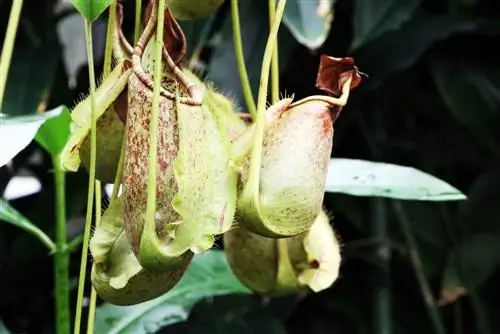
Experience has shown that propagation through cuttings has proven to be the easiest and most successful method. It is therefore the ideal method for all hobby gardeners who want to try propagating this carnivorous plant for the first time.
Step 1: Wait for a suitable time
The best time to try propagating Nepenthes is late spring. The winter with its darkness is then over, the vegetation has fully set in on the pitcher plant. If it has been well overwintered, this will now be reflected in he althy and rapid growth. These are ideal conditions for growing new pitcher plants from head cuttings. The cutting still has enough time throughout the summer in optimal conditions, namely lots of warmth and lots of light, to root well and start its own growth.
Step 2 Win offshoots
The basis for the creation of a new pitcher plant is a he althy and well-developed offshoot. It is therefore important that the mother plant is he althy, well cared for and growing. In addition to the high shoot, it should have at least one side shoot. However, for the offshoot, the high shoot of the old plant must be beheaded.
- cut the cutting directly on the trunk
- cut between two sheets
- Cuttings should be 10 -15 cm long
- Cutting should have 2-3 eyes
- Use a clean and sharp knife
- Do not cut side shoots
Don't worry, the "headless" plant may look unsightly at first, but it will certainly survive cutting. It is extremely easy to cut. It doesn't take long before she sprouts new young shoots.
Tip:
If a large Nepenthes is shortened by cutting measures, the resulting cutting residue can be used wonderfully for propagation.
Step 3: Plant offshoots
The offshoot obtained from the old pitcher plant should be planted immediately. The ideal soil temperature is 35 degrees Celsius.
- Procure a suitable substrate. It should be moist and nutrient-rich.
- Fill a small flower pot with the substrate.
- Plant the cutting.
- Put an air-permeable film over it to keep the humidity high.
- Give the potty a bright but not too sunny location.
- Air the plastic cover occasionally to prevent mold from forming.
- After about 3 to 4 weeks, new roots will have formed.
Tip:
Instead of planting the cutting immediately, it can first be placed in a glass container with lime-free water for rapid root development. After sufficient roots have formed on the cutting, it can be planted in a pot with soil for orchids.

Step 4: Repot the plants
As soon as new, tender roots have formed and the cutting is well rooted, the new pitcher plant needs a new pot.
- choose a larger container
- use substrate suitable for pitcher plants
- or a mixture of sand and peat as well as some clay
- pay attention to the tender roots when repotting
Propagation by separating side shoots
If you have a fully grown pitcher plant that has optimal growing conditions, it will produce new “offspring” on its own. If it receives plenty of food and sufficient moisture, it will sprout new small offshoots directly from the substrate. This creates miniature pitcher plants directly on the main stem. You can grow independent Nepenthes from this.
- wait until two to three new offshoots have formed
- they should be approx. 15 cm tall
- separate from the mother plant
- plant each cutting separately in a new small pot
- only use carnivore soil
- water well and keep moist
- place in a bright and warm place
- ensure high humidity
Soon after planting, the small pitcher plants continue to grow, all the better if the conditions are optimal.
Propagation via leaf cuttings
Vegetative propagation is also possible via leaf cuttings. This method is quite often successful. To do this, fill a small container with peat and moisten it well. Separate a leaf from the mother plant and place it on the peat, covering the stem with a little peat. After some time, roots will form at the end of the stem. High humidity also promotes root formation. Cover the pot with cling film, which you only open occasionally for ventilation.
In a bright place without direct sun, the leaf develops into a new plant that first forms roots and then sprouts new leaves. Once roots and a few leaves have formed, the young plant needs to be transplanted into carnivore soil.
Propagation by seeds
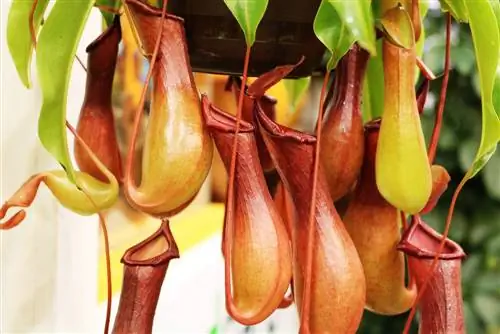
Nepenthes, which grow as houseplants, rarely develop seeds. Most of them are also bred hybrid varieties whose seeds cannot be used to grow new pitcher plants. So the main challenge is to get fresh, germinable seeds. Purchasing it for sale does not guarantee that the seeds are really fresh. There is always a risk as to whether the seeds will actually germinate after painstaking preparatory work. But there are definitely advantages to this method. Below is an overview of the essential points:
- Seed formation only occurs at the age of several years
- Pollination required, if necessary help with a brush
- the fine seed does not last long
- only a few weeks or even days
- is difficult to store
- Buying seeds is a matter of trust
- slowest method of propagation
- Spring and summer are ideal for sowing
- Germination time about one to two months
- Advantage: many new plants
- Mother plant is not weakened by pruning
- genetic diversity is promoted
- new plant is not identical to the mother plant
Instructions for sowing seeds
If suitable seeds are available, propagation must begin as quickly as possible. Here's how to do it:
- Fit a pot with suitable material, for example peat, sphagnum, coconut or pulp. Germination should also work with normal potting soil.
- Spread the seeds on top, but do not scatter them too closely. If you have a lot of seeds, it is better to use a larger pot or a new one.
- These seeds germinate in light and should not be covered with soil, or only lightly.
- Press the seeds lightly and water them. Only use lime-free water for watering. Rainwater is also good for this.
- Place the pot in a partially shaded location at a temperature of around 25 degrees Celsius.
- Keep the substrate moist at all times.
- Ensure high humidity. Plastic wrap over the pot has worked well for this. Don't forget to ventilate it regularly to prevent mold from forming.
- As soon as the first seedlings appear, select the strongest ones and transplant them into their own container with carnivore soil. Be careful of the delicate roots, they can break easily at this stage of growth.
Note:
Many varieties are protected species. If you order seeds from abroad, you need to make sure that you are actually allowed to import these seeds. Otherwise you can quickly find yourself liable to prosecution.
Give the young Nepenthes a suitable location
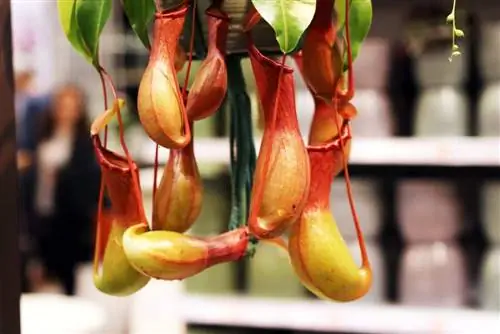
So that the new pitcher plant develops well and all the effort of propagation is not in vain, give it a suitable location.
The following applies to highland species:
- Terrarium is good
- otherwise bright place
- if applicable illuminated by additional plant lamp
- no direct sunlight
- very high humidity, best at 70%
- warm during the day around 25 degrees Celsius
- at night the temperature can drop to up to 10 degrees Celsius.
Lowland species have similar requirements to highland plants. However, they like consistently high temperatures around 30 degrees Celsius. This temperature is not consistently reached in any room, which is why they only belong in a terrarium or greenhouse. If the new plant does not receive this warmth and humidity, it cannot continue to thrive. Newly bred hybrid varieties can also cope with different living conditions. Normal room temperatures and lower humidity are often sufficient for you.
Take care of the young “pot” properly
The new pitcher plant needs proper care from day one to grow big and strong. A good substrate is the be-all and end-all of optimal care.
- air-permeable and water-permeable substrate
- should be able to store water without forming waterlogging
- not normal potting soil
- must be kept constantly moist
- water daily during the vegetation phase
- always pour over coasters, never from above
- never use hard water
- Rainwater is soft and good for carnivores
- usually no fertilization required
- some orchid fertilizer in spring is good for growth
- the growing plant needs a new pot regularly
Observe the young pitcher plant as it develops in its location with the care given to it. If growth delay sets in or other problems arise, countermeasures must be taken in good time. Maybe a new location is due or something isn't going well with the maintenance.
Overwintering the new plants
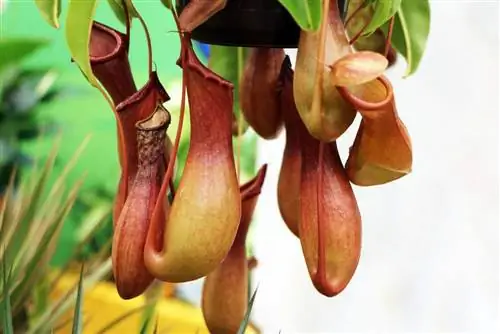
By the first winter, the pitcher plant should be large enough to survive the upcoming period of less light. In order for it to continue to thrive, it must have certain living conditions even in winter. How exactly a pitcher plant should be overwintered depends largely on the variety. Pitcher plants grow at different heights, which provide them with different climatic conditions. A distinction is made between highland species and lowland species. There are now also numerous breeding hybrids that generally require less care. If you don't already know what variety the mother plant is, clarify. The newly created plant is identical to the mother plant and should be overwintered just like it.
- the ideal location offers a lot of brightness
- additional plant lamp is necessary in winter
- Fertilizer is not needed
- the water requirement is lower than in summer
- Continuous 20 to 30 degrees Celsius day and night, is ideal for lowland species
- Highland pitcher plants like 10 to 16 degrees Celsius at night

